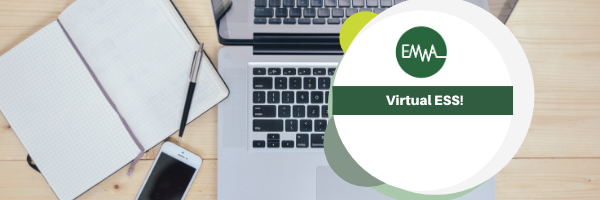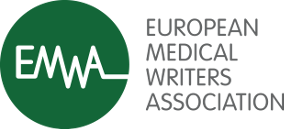Virtual ESS!
Virtual ESS

EMWA goes virtual!
Come and join us for EMWA’s second virtual Expert Seminar Series (ESS) on medical devices
Life cycle safety and risk management for medical devices – an integrated approach
Date: Wednesday, 7 October 2020, from 14:00 to 17:00 CEST (Please ensure you check the time for your location prior to the event).
This Expert Seminar covers the safety and risk management of the full life cycle of a medical device, from its development to post-marketing surveillance.
The new European Medical Device Regulation (EU MDR) 2017/745, the new edition of ISO 14971, and the new standardised terminology corresponding to relevant IMDRF (International Medical Device Regulators Forum) codes will be discussed with a focus on the integrated approach that is needed to adhere to these regulations and guidelines.
This seminar will provide information relevant to the spectrum of medical writers, regardless of their experience. It targets medical writers/ communicators interested in embarking on work in this field as it will present an overview of regulations, department structures, and key aspects of safety reporting and risk management. Pharmacovigilance writers will benefit from the short introduction of key differences between the medical device world and the pharmaceutical industry. Furthermore, experienced medical device writers/ safety or risk management officers, as well as heads of departments will benefit from the insights into the latest developments, from the experience of other companies in establishing an integrated approach, and from the panel discussion that will allow the audience to ask safety- or risk management-related questions.
Please email head office with any questions or accessibility concerns.
Programme
14:00-14:20
Introduction to Pharmacovigilance Writing for medicinal products
Tiziana von Bruchhausen, PhD, Boehringer Ingelheim
This introduction aims to provide a basis for the subsequent presentations and to support a discussion related to the differences between pharmacovigilance writing for medicinal products and pharmacovigilance writing for medical devices. The main pharmacovigilance requirements in the life cycle of a medicinal product will be briefly described from a writing perspective: the main actors of a “never ending story”, as well as the associated concepts, scope, and challenges that accompany the different stages of the life cycle of a medicinal product.
14:20-14:50
Introduction to medical writing for medical devices – Clinical Safety (Pre- and post- market studies)
Dr. Birgit Jorg, Edwards Lifesciences
Are you pharma-based and have you always wanted to glimpse into the medical device world? Or are you working in medical devices andconsidering a career in Clinical Safety?
This presentation will provide a 360° overview on Clinical Safety. Differences between the medical device world and the pharmaceutical industry will be discussed; relevant regulations and guidelines will be introduced. Documents for which the skills of a medical writer/ communicator may be particularly useful will be shown.
An example structure of a safety department will be provided and the Adverse Event workflow/ safety process will be described, from “beginning” (date of awareness) to “end” (report).
Furthermore, cross-functional collaboration with internal and external stakeholders will be explained as this is gaining more importance under the MDR (EU) 2017/745.
5-MINUTE BREAK
14:55-15:35
Systematic and proactive post-market surveillance – an integral part of a manufacturer's quality management system
Markus Pöttker, Smith & Nephew
The European Medical Device Regulation (EU MDR) aims to establish a robust, transparent, predictable, and sustainable regulatory framework for medical devices to assure high quality and safety for medical devices in Europe. Fundamental recent changes include a greater focus on clinical benefit and evidence, as well as post-market surveillance (PMS). The regulation improves transparency through standardised data and the establishment of a comprehensive EU database of medical devices.
In this presentation, we will explore the new proactive elements of post-market surveillance and will compare these with passive feedback and reactive post-market surveillance. We will also look at how to establish and structure a proactive post-market surveillance system for medical devices. This includes strategies for data generation and evaluation.
Finally, the seminar will provide an overview and explain the goals of the IMDRF Adverse Event coding system. We will discuss utilization of the IMDRF AE coding system as an integrator of the different elements of the product surveillance system - from clinical studies over ‘Complaint Handling’ and PMS to ‘Risk Management’. We will further explore how the coding system can help to establish standardised language and integrate the post-market collected data into risk management.
5-MINUTE BREAK
15:40-16:10
Risk management for medical devices and the new edition of ISO 14971
Dr. Jos van Vroonhoven, Philips
Risk management is an important aspect of the development of medical devices. International standard ISO 14971 provides a process to assist manufacturers in identifying the hazards associated with medical devices, assessing the corresponding risks, controlling these risks where needed, and monitoring the effectiveness of the risk control measures. This standard was recently revised and updated.
Technical report ISO/TR 24971 was revised in parallel to provide extensive guidance on the application of this risk management standard.
In the presentation, the general requirements and the detailed steps of the risk management system are reviewed, along with the associated documents such as the risk management plan, file and report. The major changes in the third edition of ISO 14971 are indicated and explained. Within the context of the European Medical Device Regulation (EU) 2017/745, it becomes even more important to understand the risk management process and the relation with all documents required by this regulation, in particular after the medical device has been introduced into the market.
The responsibility for an effective risk management system starts at the highest level in the manufacturer’s organisation with the commitment of top management. The policy for establishing the criteria for risk acceptability must be defined based on applicable regulations and international standards. All departments within the manufacturer’s organisation need to cooperate to ensure that the medical device under development is ultimately safe. The evidence needed to support this conclusion can involve usability studies, clinical investigations, and a clinical evaluation. The risk management process is a continuing life-cycle process that continues after market introduction.
5-MINUTE BREAK
16:15-17:00 pm
Q&A with our panel of experts
Moderator: Dr. Beatrix Doerr
EMWA is offering a special price for this virtual ESS €75 for EMWA member and €100 for non-members.
| Click here to register |
About our speakers:
Tiziana von Bruchhausen, PhD
Senior Global Pharmacovigilance Writer – Boehringer Ingelheim Pharma
Tiziana has been specialising in pharmacovigilance writing since 2008 and has gained extensive hands-on experience with pharmacovigilance documents and health authorities’ assessments. She has developed broad expertise with the implementation of the Good Pharmacovigilance Guidance related to risk management plans (RMPs) and periodic safety update reports (PSURs), and with the evolving concept of safety concerns. In her current position at Boehringer Ingelheim, she is responsible for the coordination and preparation of life cycle pharmacovigilance documents with a focus on development safety update reports (DSURs), RMPs, and PSURs; in addition, she is involved in pre- and post-submission activities related to the global strategic planning and health authorities’ assessment reports. Tiziana is an active volunteer for EMWA, where she has been chairing the Pharmacovigilance Special Interest Group Committee since 2017. She also provides trainings on pharmacovigilance writing for EMWA and other professional education institutions Europe-wide.
Dr. Birgit Jorg
Senior Manager, Clinical Safety TMTT, Edwards Lifesciences Services GmbH
Birgit has more than 20 years of experience in the medical device industry, more than 10 years of which have been spent in Clinical Safety. Starting in Clinical Research and moving to Clinical Safety provides a holistic view on Clinical Trials and associated processes and procedures.
Birgit has established two European Safety Teams, generated and implemented safety processes for pre-market and post-approval trials, and performs safety trainings. She and her team provide input to study documents, publications and conference presentations.
In her current position, Birgit leads the European Safety team for Transcatheter Mitral and Tricuspid Therapies (TMTT) at Edwards Lifesciences.
Markus Pöttker
Post Market Surveillance Lead – EU MDR Programme – Clinical and Medical Affairs, Smith + Nephew
Markus is a member of the EU MDR Global Project team leading the Post Market Surveillance work stream at Smith & Nephew. In this role, he is responsible to ensure that the requirements of the EU MDR are correctly interpreted, specified and implemented across the business functions, globally. Prior to this, he spent seven years in Quality & Regulatory roles, ending as Director of Complaint Management and Head of Regulatory Compliance, Complaint Intake and Closure at Smith & Nephew with global responsibility for Complaint Handling, Medical Device Reporting and interaction with Regulatory Agencies. Markus is a member of MedTech Europe PMS & Vigilance Working Group since 2012 and a member of the corresponding standard committee to ISO TC 210 at the Swiss Association for Standardization. Markus holds a master degree in law (Diplom-Jurist) from WWU Münster, Germany.
Dr. Jos van Vroonhoven
Senior Manager Standardization, Philips, The Netherlands
Jos’ 30-year career with Philips in The Netherlands comprises 15 years in Research and Development and 15 years in Healthcare. He became increasingly involved in the application of x-ray safety standards when working as a radiation protection specialist. In his current position, Jos focuses on the development of international and European standards for medical electrical equipment. He participates in several working groups of the International Standardization Organisation (ISO) and the International Electrotechnical Commission (IEC). Since 2016 he is the convener of Joint Working Group 1 (JWG1) between ISO/TC 210 and IEC/SC 62A on the application of risk management to medical devices, working on the revision of ISO 14971 and ISO/TR 24971. JWG1 has also prepared ISO/IEC Guide 63 with guidance for standards writers on the inclusion of safety aspects in international standards for medical devices.
Jos’ 30-year career with Philips in The Netherlands comprises 15 years in Research and Development and 15 years in Healthcare. He became increasingly involved in the application of x-ray safety standards when working as a radiation protection specialist. In his current position, Jos focuses on the development of international and European standards for medical electrical equipment. He participates in several working groups of the International Standardization Organisation (ISO) and the International Electrotechnical Commission (IEC). Since 2016 he is the convener of Joint Working Group 1 (JWG1) between ISO/TC 210 and IEC/SC 62A on the application of risk management to medical devices, working on the revision of ISO 14971 and ISO/TR 24971. JWG1 has also prepared ISO/IEC Guide 63 with guidance for standards writers on the inclusion of safety aspects in international standards for medical devices.

